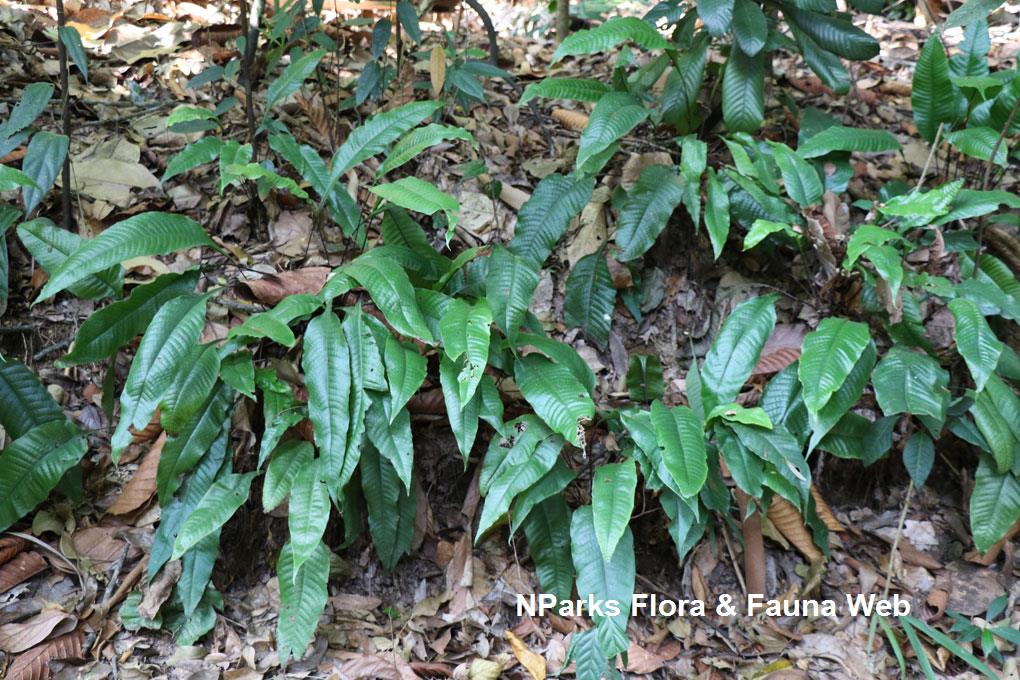.jpg)
Back
Tectaria barberi (Hook.) Copel.
| Family Name: | Tectariaceae |
| Synonyms: | Tectaria crenata auct. non Cav. <5>, Dictyopteris barberi (Hook.) Bedd., Aspidium variolosum auct. non Wall. ex Hook.<3>, Aspidium zollingerianum auct. non Kunze. <2> |
Tectaria barberi is a native fern of Singapore. It has bipinnate to bipinnatifid fronds where the lowest pair of leaflet either produce an enlarged lobe or divides further into smaller leaflets. The blade is dark green and shiny on the top while the sori are round to elongate, irregularly scattered with a lack of the protective layer, indusia.
Name
Classifications and Characteristics
| Plant Division | Ferns & Lycophytes (Non-Seed Vascular Plants) (Fern) |
|---|---|
| Plant Growth Form | Herbaceous Plant |
Biogeography
| Native Distribution | Malesia, Borneo, Myanmar, Thailand, Sumatra |
|---|---|
| Native Habitat | Terrestrial (Primary Rainforest) |
| Preferred Climate Zone | Tropical |
| Local Conservation Status | Native to Singapore (Least Concern (LC)) |
Description and Ethnobotany
| Growth Form | It is an terrestrial fern with short-creeping rhizomes. |
|---|---|
| Foliage | When young, the fronds are 3 to 5 lobed with smooth margins. Fronds are usually bipinnatifid when small and bipinnate as they get larger. It is dark green coloured, slightly shiny on the top surface. Each frond holds up to 7 pairs of leaflet with its lowest pair producing either an enlarged lobed (bipinnatifid) or further divided into smaller leaflets (bipinnate). Held to a long dark brown stalk to 70 cm long, the blade can reach to 50 cm in length. |
| Reproductive Parts - non-flowering plant | The sori are small, round or oblong found on the underside, irregularly scattered. The protective layer, indusia is absent. |
| Others - Plant Morphology | The rhizomes are erect, short-creeping, the tips of the rhizomes and base of the stalk are covered in narrow to linear, stiff brown scales. |
| Habitat | Occurs in primary forest, near streams in forest near sea level. <1, 4> |
| Similar | Tectaria barberi and Tectaria incisa are similar in appearance. The key differences are found in the sori. The sori of Tectaria barbei are small, round to oblong, irregularly scattered on the underside. They also lack an indusia which is present in Tectaria incisa. The latter also have large, round to kidney-shaped sori with a presence of a round to kidney shaped indusia. |
| Cultivation | It can be propagated by spores. |
Landscaping Features
Plant Care and Propagation
| Light Preference | Semi-Shade |
|---|---|
| Water Preference | Moderate Water |
| Plant Growth Rate | Moderate |
Foliar
| Mature Foliage Colour(s) | Green |
|---|---|
| Foliar Type | Simple / Unifoliate |
| Foliar Margin | Entire, Sinuate |
| Foliar Apex - Tip | Caudate, Acuminate |
| Foliar Base | Cuneate, Rounded / Obtuse |
References
| References | <1> Holttum, R.E. (1991). Tectaria. In: Holttum, R.E. (eds), Dryopteridaceae, Flora Malesiana, ser. 2, Pteridophyta, vol. 2, pt. 1, pp. 52. Leiden: Rijksherbarium. <2> Ridley, H.N. (1900). The Flora of Singapore. J. Straits Branch Roy. Asiat. Soc. 33: 191. <3> Ridley, H.N. (1908). A List of the Ferns of the Malay Peninsula. J. Straits Branch Roy. Asiat. Soc. 50: 33. <4> Tagawa, M. & Iwatsuki, K. (1988). Flora of Thailand, vol. 3(3), pp. 371 - 372. Bangkok: The Forest Herbarium, Department of National Parks, Wildlife and Plant Conservation. <5> Turner, I.M. & Chua, K.S. (2011). Checklist of the vascular plant species of the Bukit Timah Nature Reserve. Raffles Museum of Biodiversity Research pp. 24. |
|---|
Image Repository
Others
| Master ID | 1982 |
|---|---|
| Species ID | 3274 |
| Flora Disclaimer | The information in this website has been compiled from reliable sources, such as reference works on medicinal plants. It is not a substitute for medical advice or treatment and NParks does not purport to provide any medical advice. Readers should always consult his/her physician before using or consuming a plant for medicinal purposes. |

.jpg)
.jpg)
.jpg)
.jpg)
.jpg)

.jpg)

.jpg)